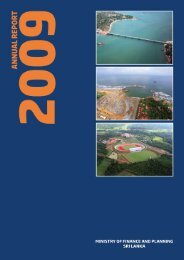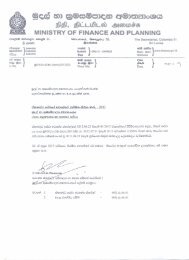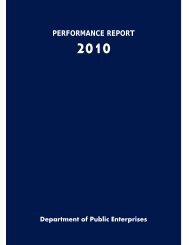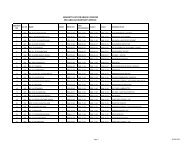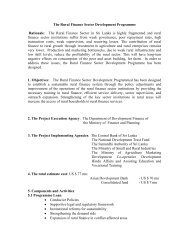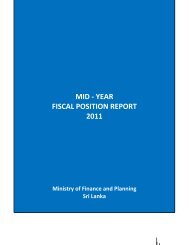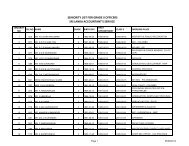Annual Report 2010 - Ministry of Finance and Planning
Annual Report 2010 - Ministry of Finance and Planning
Annual Report 2010 - Ministry of Finance and Planning
You also want an ePaper? Increase the reach of your titles
YUMPU automatically turns print PDFs into web optimized ePapers that Google loves.
<strong>Ministry</strong> <strong>of</strong> <strong>Finance</strong> <strong>and</strong> <strong>Planning</strong> Sri Lanka > <strong>Annual</strong> <strong>Report</strong> <strong>2010</strong>six years. This necessitates increasingwater use efficiency in irrigation <strong>and</strong>tapping non-conventional modes <strong>of</strong>water supply effectively. This includeswater recycling, large scale rain waterharvesting systems, desalination etc.A consistent investment on drinkingwater is assured to achieve the target<strong>of</strong> 95 percent safe drinking water coverageby 2015.Environmentally FriendlyUrban DevelopmentGovernment aims to develop a network<strong>of</strong> cities <strong>and</strong> townships which are wellconnected with each other <strong>and</strong> the rest<strong>of</strong> the world. Colombo <strong>and</strong> other maincities are to be developed as green cities.Solid waste management, drainage<strong>and</strong> sewerage facilities, implementation<strong>of</strong> zoning plans, developing systematictransport facilities <strong>and</strong> minimizingtraffic congestions are the main thrustsidentified in the urban sector.Sports EconomyMajor sport events will boost theeconomy <strong>and</strong> global image <strong>of</strong> thecountry. This type <strong>of</strong> activities allows acountry to cope up with wide range <strong>of</strong>issues which in turn help to accelerateeconomic development. Major sportevents boost tourism, improveinfrastructure, organizational capacity<strong>and</strong> media coverage etc.International level sport relatedpr<strong>of</strong>essionals such as trainers, coaches,umpires, physiotherapists, etc. can alsobe a valuable asset in this sector.In the backdrop <strong>of</strong> this comprehensivepolicy regime, the year <strong>2010</strong> wasexpected to lay the foundation forsuch development aspirations. Towardsrealizing this goal, internationallyaccepted stadiums <strong>and</strong> other sportrelated infrastructure have beendeveloped at provincial level <strong>and</strong>national level to promote a sportbasedeconomy.Self Economy –Divi NegumaThe one million home economy units(backyard economies) programmehas been designed to encourage awide range <strong>of</strong> economic activitiesspanning from gardening, vegetable/fruitcultivation, environmentfriendly living arrangements, homebased industries, <strong>and</strong> services etc.to insulate households from variousmarket vulnerabilities on their livingas well as to promote healthy familylifestyles, particularly <strong>of</strong> ruralSri Lanka.Macroeconomic OverviewThe Sri Lankan economy registered animpressive growth rate <strong>of</strong> 8 percentin <strong>2010</strong> with strong performancein all three sectors <strong>of</strong> agriculture,manufacturing <strong>and</strong> services therebyrecovering robustly from the lowergrowth rate <strong>of</strong> 3.5 percent recordedin 2009. This was the second highestannual growth rate achieved sincethe independence in 1948. Withthis encouraging performance, thecountry’s per capita income hasincreased to USD 2,399 in <strong>2010</strong> fromUSD 2,057 in 2009.The economic growth in <strong>2010</strong> wasunderpinned by a number <strong>of</strong> majorfactors;− the steady recovery <strong>of</strong> domesticeconomic activity <strong>and</strong> the enhancedinvestor confidence in the midst <strong>of</strong>extremely peaceful environment inthe country following the successfulcompletion <strong>of</strong> the humanitarianoperation in May 2009− the post-conflict economic reintegration<strong>of</strong> Northern <strong>and</strong> Easternprovinces− Government’s committed efforts inresolving infrastructure bottleneckswhile continuing rehabilitation,reconstruction <strong>and</strong> livelihoodrestoration activity in the conflictaffected areas− pursuance <strong>of</strong> conducive policieswhich are blended from pastmistakes, prevailing conditions <strong>and</strong>emerging developments in thedomestic <strong>and</strong> international arena− improved macroeconomicconditions <strong>and</strong>− the gradual recovery <strong>of</strong> the globaleconomy from one <strong>of</strong> the deepesteconomic recessions, which wasoriginated consequent to the globalfinancial crisis experienced in 2008.Real Economy GrowthIn <strong>2010</strong>, the Agriculture sector grewby 7 percent compared to the lowergrowth <strong>of</strong> 3.2 percent recorded in2009 thereby strengthening thesupply side <strong>of</strong> the economy to reduceinflation while providing employmentopportunities, particularly for thepeople in the rural sector. Reflectingthe gradual recovery <strong>of</strong> domestic <strong>and</strong>external dem<strong>and</strong>, the Industry sectorindicated a growth rate <strong>of</strong> 8.4 percent,the highest since 2002, supported by ahealthy growth in all the sub sectors inthe economy.25





